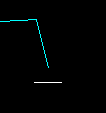Preferences: Cursor
Purpose
The Cursor preferences panel provides customization options for the size and visualization of the Neurolucida 360 software cursor.
Access cursor preferences from File > Preferences > Cursor.
The two parts of the cursor
Crosshairs: The intersection of the crosshairs indicates the (X,Y) position of the cursor, and is where
Circular cursor: The center of the circular cursor is at the same position as the center of the crosshairs. The diameter of the circular cursor is adjustable and dictates the thickness of
Settings
Crosshair size: To change the cursor crosshairs length, choose pixels or microns from the dropdown menu, then enter a size in the text box, or use the up and down arrows next to the text box.
You can change the size of the cursor crosshairs by clicking Ctrl+Up/Down arrow on the keyboard.
It is often useful to set the cursor crosshairs to a known size for a rapid comparison of objects on the screen.
If you set the size in microns, the cursor changes size when a new lens is selected; its size remains constant when set in pixels.
Diameter: To change the circular cursor diameter, enter a micron size in the text box, or use the up and down arrows next to the text box.
The circular cursor is drawn as close as possible to the specified size; accuracy depends on the micron to pixel ratio of the current lens.
When mouse wheel focus is not enabled, you can change the size of the circular cursor by scrolling the mouse wheel.
The size of the circular cursor dictates the thickness of
Neurolucida 360 always records the circular cursor size during tracing.
To show the line thickness:
- Go to File>Preferences>Tracing.
- Under View, check Display line Thickness.
Thickness: To change the cursor thickness, enter a pixel size in the text box, or use the up and down arrows next to the text box. Increasing the thickness of the cursor can make it easier to see on the screen.
Use Fast Cursor: Check the box to improve the reactivity of the cursor and decrease lag time when moving around the screen.
Show diameter of the cursor in the status bar: Check the box to display the circular cursor diameter in the status bar following the (X,Y,Z) positions.
Show size of the crosshair in the status bar: Check to the box to display the cursor crosshairs length in the status bar following the (X,Y,Z) positions and circular cursor diameter if displayed.
Use pen buttons for circular cursor sizing: Check the box to enable adjustment of the circular cursor diameter with pen buttons when using a pen tablet.
Click to select a new color for the cursor.
Blinking cursor
When tracing, the last point placed is typically highlighted with a blinking marker. The shape, size, and speed of the blinking cursor can be customized.
Blinking mark style: Select the desired blinking mark style from the dropdown list:
|
none
|

|
| circle |

|
| cross hair |

|
| Wheel: rotates around last point clicked. |

|
| Circuit: rotates around last point clicked. |

|
A slow blinking mark may be hard to locate, but it doesn't obscure structures on the screen, while the blinking speed of a wheel-shaped marker may be increased without significantly affecting image clarity, but the exact position of the previously traced point may not be as clear.
Radius of the mark: To change the blinking mark radius, manually enter a specified pixel size in the text box, or use the up and down arrows next to the text box.
Blinking rate: The blinking rate is adjusted by moving the slider from slow to fast. A slow blink translates into a relatively long appearance followed by an equally long disappearance.